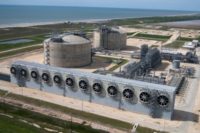Investigators looking into an April 2019 fire that destroyed a 2-MW grid-connected lithium ion battery storage array owned by utility Arizona Public Service found that it was an extensive “cascading thermal runaway” and not a fire that caused the unit to explode.
The thermal runaway began when an internal battery cell failed because of a defect, specifically, an abnormal lithium metal deposit and dendritic crystal growth in the cell. The internal fire suppression system operated as designed, but the system was not capable of preventing or stopping thermal runaways.
“As a result, thermal runaway cascaded and propagated through every cell and module via heat transfer,” according to the analysis performed by DNV GL Energy Insights USA in a report for APS. The utility submitted the report to state regulators July 27 and also released it to the public.
An APS operations executive described the event, which injured nine first-responders, “as clearly a tragic equipment failure.”
Thermal runaway is caused when the temperature of a lithium ion battery exceeds 150° C and causes a reaction between the cathode and the electrolyte that releases heat that makes the reaction go faster, said George W. Crabtree, director of Argonne National Laboratory’s Joint Center for Energy Storage Research. The reaction is well known, he said.
The battery storage unit charges with solar energy during the day and discharges power into the grid at night. It is the size of a standard shipping container and had 36 vertical racks, 27 of which had 14 battery modules containing 28 lithium ion battery cells. The absence of adequate thermal barriers between cells at the Arizona battery storage unit in Surprise, Ariz., allowed the thermal runaway to move from module to module in the array, the investigators said.
The uncontrolled cascading of thermal runaway led to the production of a large quantity of flammable gasses within the battery energy storage system, the report said. The emergency response plan did not have an extinguishing, ventilation and entry procedure, so when firefighters opened the door to the system, the flammable gasses exploded, it noted.
“While today’s energy storage safety codes and standards acknowledge cascading thermal runaway as a risk, they stop short of prohibiting it, and fail to address the risk of non-flaming heat transfer to neighboring cells, modules, and racks,” the investigators said. Instead they focus on ways to manage a fire but have not prescribed a solution to restrict or slow cell-to-cell and module-to-module thermal runaway propagation, according to the report.
Investigators noted, however, that there are commercially available technologies to address thermal runaway propagation. “Better practices for ventilation, extinguishing, and cooling thermal runaway scenarios exist today and should be implemented in future energy storage systems,” the report said.
The utility also hired Wood Environment & Infrastructure Solutions and AECOM Technical Services to assess any environmental hazards such as release of particulate matter or heavy metals. Their assessment said impacts were "confined to onsite locations near the structure", with further offsite probes "not recommended."
Calls to Arlington, Va.-based AES Corp., which designed and built the battery energy storage system for APS, were not responded to by ENR press time on July 29. The energy company also built a second unit for the utility.
But in July 30 comments to Arizona regulators, battery manufacturer LG Chem Lid., takes issue with the DNV analysis steps and conclusions, contending that its own outside analysis pointed to an external heat source, such as external electrical arcing, as the potential cause.
APS's plan to install an estimated $1 billion in energy-storage batteries in its service areas were put on hold after the explosion, says one local report. The storage buildup is part of its announced intention to obtain 45% of its energy from renewable sources such as solar and wind by the end of the decade.





Post a comment to this article
Report Abusive Comment